2004 MITSUBISHI ENDEAVOR ac evaporator
[x] Cancel search: ac evaporatorPage 1999 of 3870

When metering R-134a into the refrigeration system, keep the supply tank or cans
in an upright position. If the refrigerant container is on its side or upside down,
liquid refrigerant will enter the system and damage the compressor.
Refrigerant will tarnish bright metal and chrome surfaces, and in combination with
moisture can severely corrode all metal surfaces. OPERATION CONDENSER FAN AND RADIATOR FAN CONTROL For the operation of each fan, refer to
SYMPTOM CHART
.
COMPRESSOR CONTROL WHEN OPERATING THE AIR CONDITIONING SWITCH
The air thermo sensor, which senses the temperature of the air flowing out of
the evaporator, deactivates the compressor at 3°C (37.4°F) or below. The dual pressure switch turns OFF when the refrigerant pressure becomes
excessively high or low, thus protecting the compressor circuit. When the air thermo sensor is activated, and the ignition switch, blower switch,
and air conditioning switch are ON, the A/C compressor clutch relay is
energized.
WHEN OPERATING THE MODE SELECTION DIAL
The air conditioning will work when the mode selection dial is set to the
"Defroster" or "Defroster/foot" position, or the temperature control dial is set to
the "MAX A/C" position. In other dial positions, when the air conditioning
switch is turned on, the air conditioning will work.
A/C COMPRESSOR CLUTCH RELAY ON CONDITIONS
2004 Mitsubishi Endeavor LS
2004 HVAC Heater Air Conditioning, Ventilation - Endeavor
Page 2002 of 3870
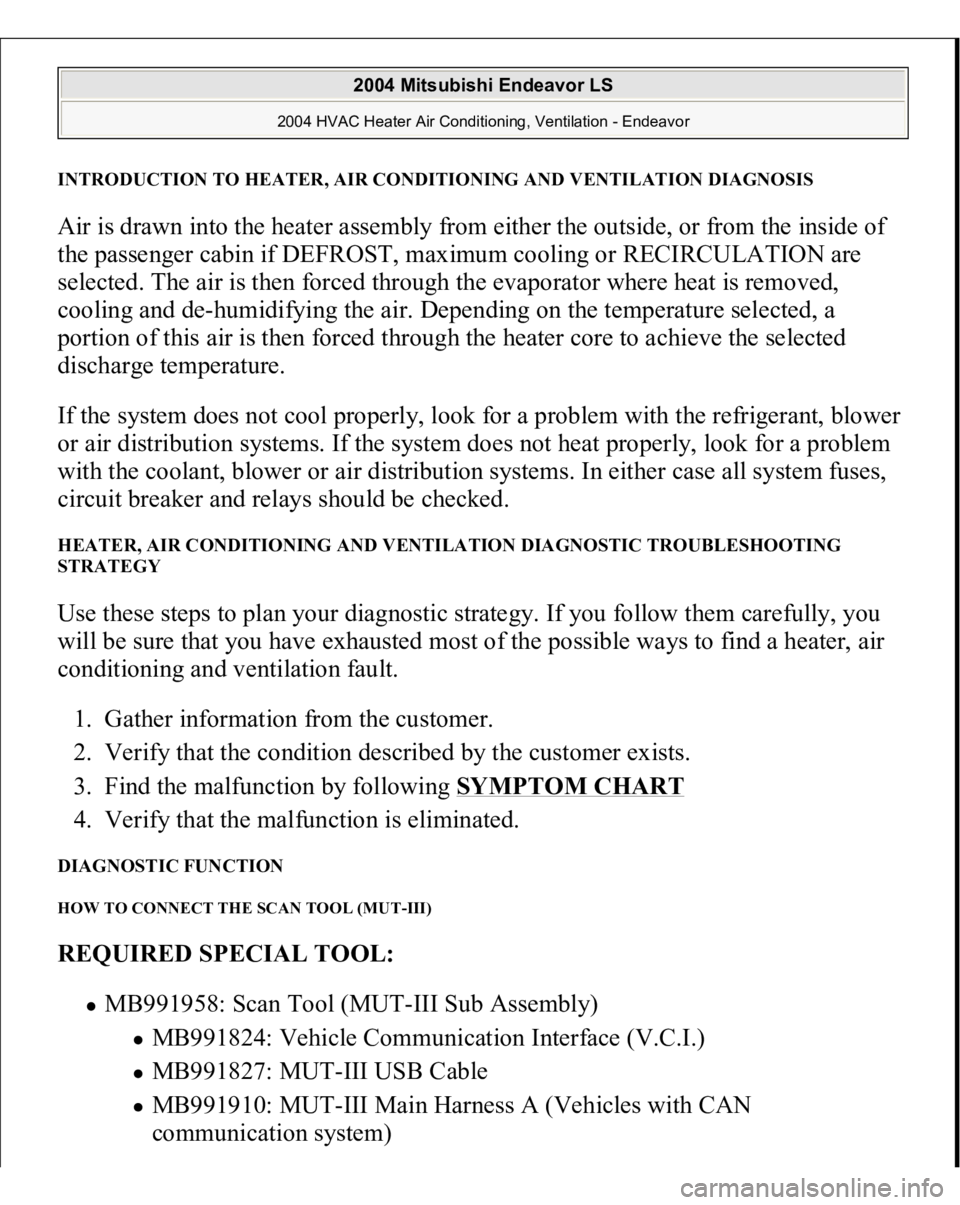
INTRODUCTION TO HEATER, AIR CONDITIONING AND VENTILATION DIAGNOSISAir is drawn into the heater assembly from either the outside, or from the inside of
the passenger cabin if DEFROST, maximum cooling or RECIRCULATION are
selected. The air is then forced through the evaporator where heat is removed,
cooling and de-humidifying the air. Depending on the temperature selected, a
portion of this air is then forced through the heater core to achieve the selected
discharge temperature.
If the system does not cool properly, look for a problem with the refrigerant, blower
or air distribution systems. If the system does not heat properly, look for a problem
with the coolant, blower or air distribution systems. In either case all system fuses,
circuit breaker and relays should be checked. HEATER, AIR CONDITIONING AND VENTILATION DIAGNOSTIC TROUBLESHOOTING
STRATEGY Use these steps to plan your diagnostic strategy. If you follow them carefully, you
will be sure that you have exhausted most of the possible ways to find a heater, air
conditioning and ventilation fault.
1. Gather information from the customer.
2. Verify that the condition described by the customer exists.
3. Find the malfunction by following
SYMPTOM CHART
4. Verify that the malfunction is eliminated.
DIAGNOSTIC FUNCTION HOW TO CONNECT THE SCAN TOOL (MUT-III) REQUIRED SPECIAL TOOL:
MB991958: Scan Tool (MUT-III Sub Assembly)
MB991824: Vehicle Communication Interface (V.C.I.) MB991827: MUT-III USB Cable MB991910: MUT-III Main Harness A (Vehicles with CAN
communication system)
2004 Mitsubishi Endeavor LS
2004 HVAC Heater Air Conditioning, Ventilation - Endeavor
Page 2365 of 3870
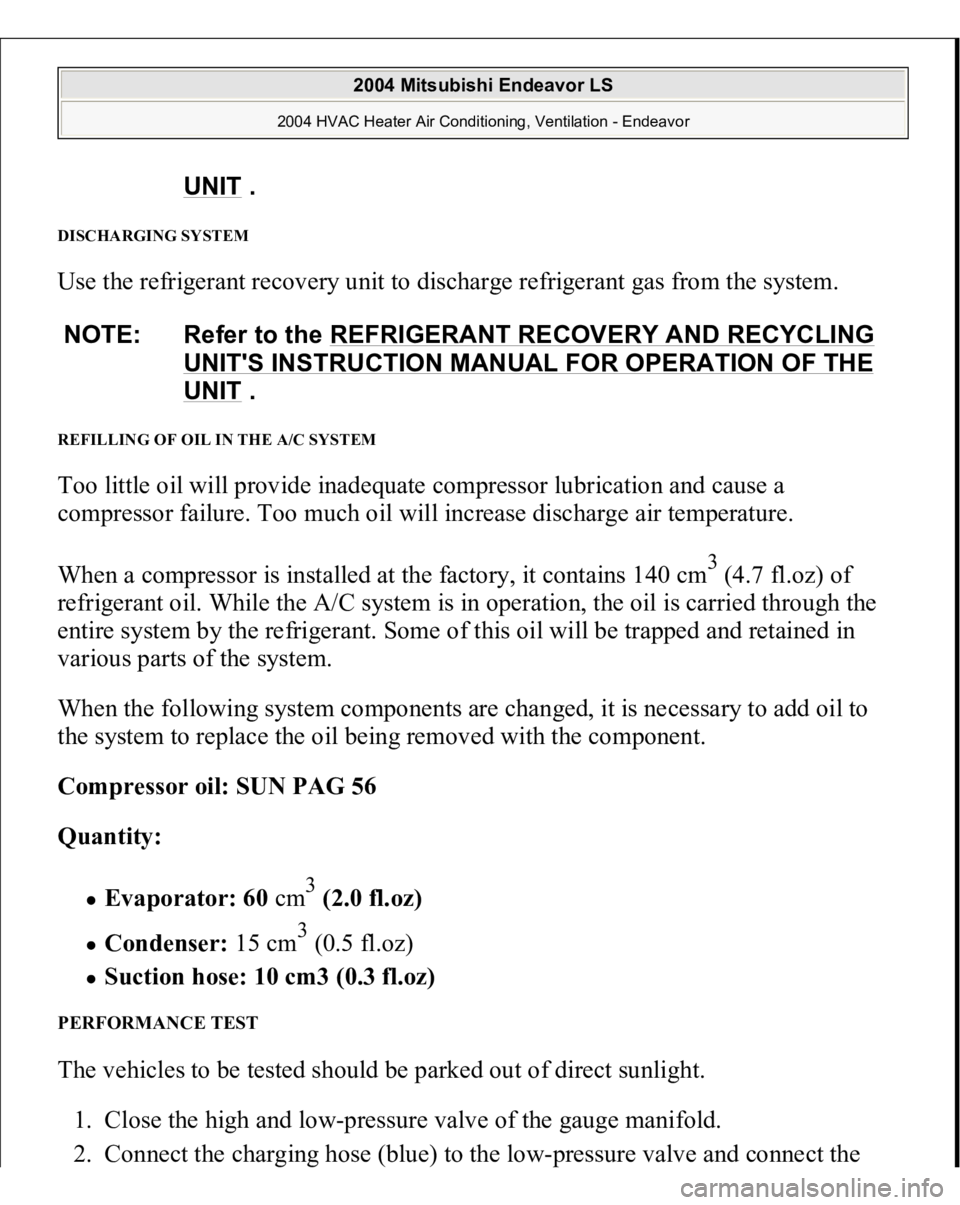
DISCHARGING SYSTEM Use the refrigerant recovery unit to discharge refrigerant gas from the system. REFILLING OF OIL IN THE A/C SYSTEM Too little oil will provide inadequate compressor lubrication and cause a
compressor failure. Too much oil will increase discharge air temperature.
When a compressor is installed at the factory, it contains 140 cm
3 (4.7 fl.oz) of
refrigerant oil. While the A/C system is in operation, the oil is carried through the
entire system by the refrigerant. Some of this oil will be trapped and retained in
various parts of the system.
When the following system components are changed, it is necessary to add oil to
the system to replace the oil being removed with the component.
Compressor oil: SUN PAG 56
Quantity:
Evaporator: 60
cm
3 (2.0 fl.oz)
Condenser:
15 cm
3 (0.5 fl.oz)
Suction hose: 10 cm3 (0.3 fl.oz)
PERFORMANCE TEST The vehicles to be tested should be parked out of direct sunlight.
1. Close the high and low-pressure valve of the gauge manifold.
2. Connect the charging hose (blue) to the low-pressure valve and connect the
UNIT
.
NOTE: Refer to the REFRIGERANT RECOVERY AND RECYCLING
UNIT'S INSTRUCTION MANUAL FOR OPERATION OF THE UNIT
.
2004 Mitsubishi Endeavor LS
2004 HVAC Heater Air Conditioning, Ventilation - Endeavor
Page 2379 of 3870
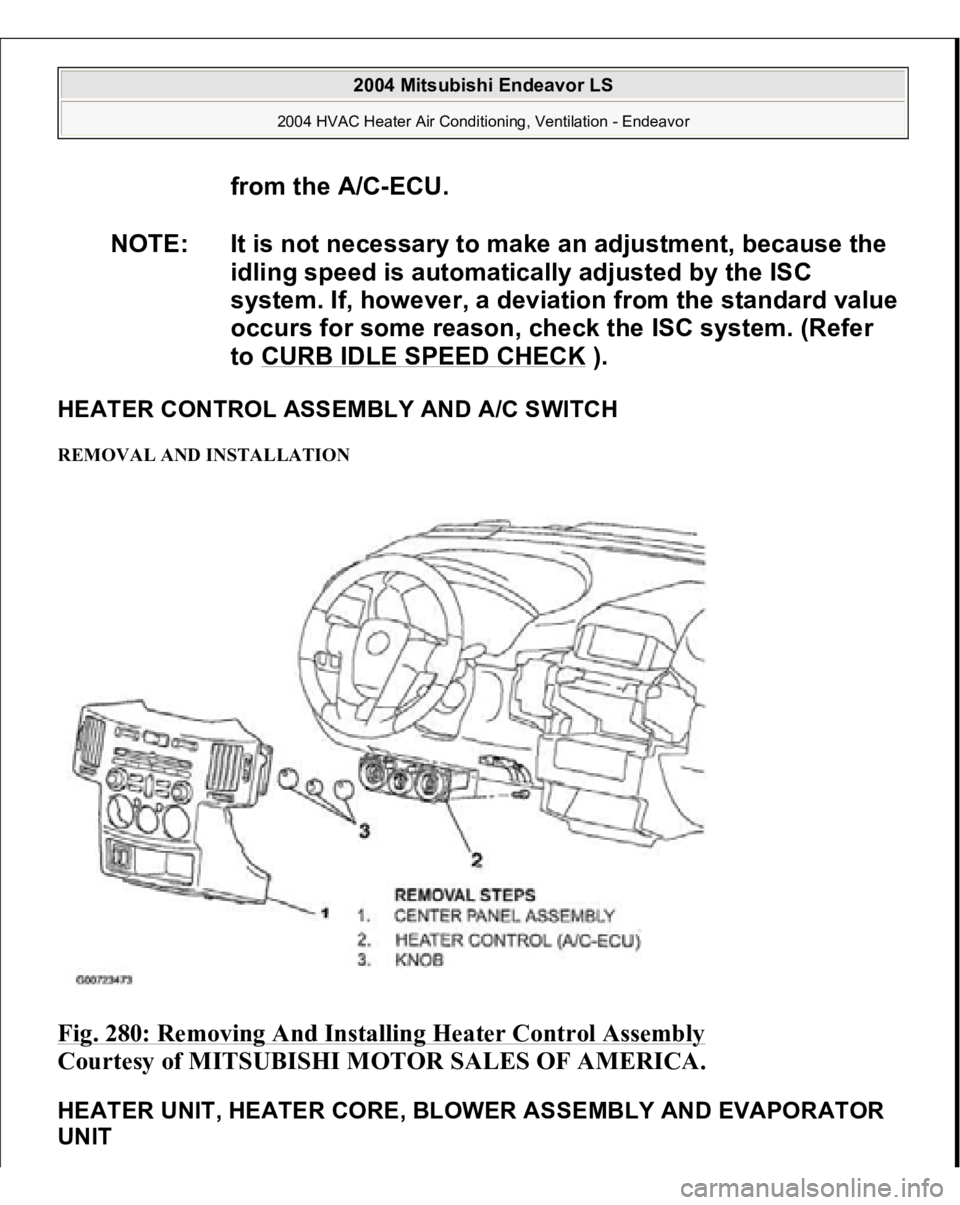
HEATER CONTROL ASSEMBLY AND A/C SWITCH REMOVAL AND INSTALLATION Fig. 280: Removing And Installing Heater Control Assembly
Courtesy of MITSUBISHI MOTOR SALES OF AMERICA.
HEATER UNIT, HEATER CORE, BLOWER ASSEMBLY AND EVAPORATOR
UNIT
from the A/C-ECU.
NOTE: It is not necessary to make an adjustment, because the
idling speed is automatically adjusted by the ISC
system. If, however, a deviation from the standard value
occurs for some reason, check the ISC system. (Refer
to CURB IDLE SPEED CHECK
).
2004 Mitsubishi Endeavor LS
2004 HVAC Heater Air Conditioning, Ventilation - Endeavor
Page 2399 of 3870
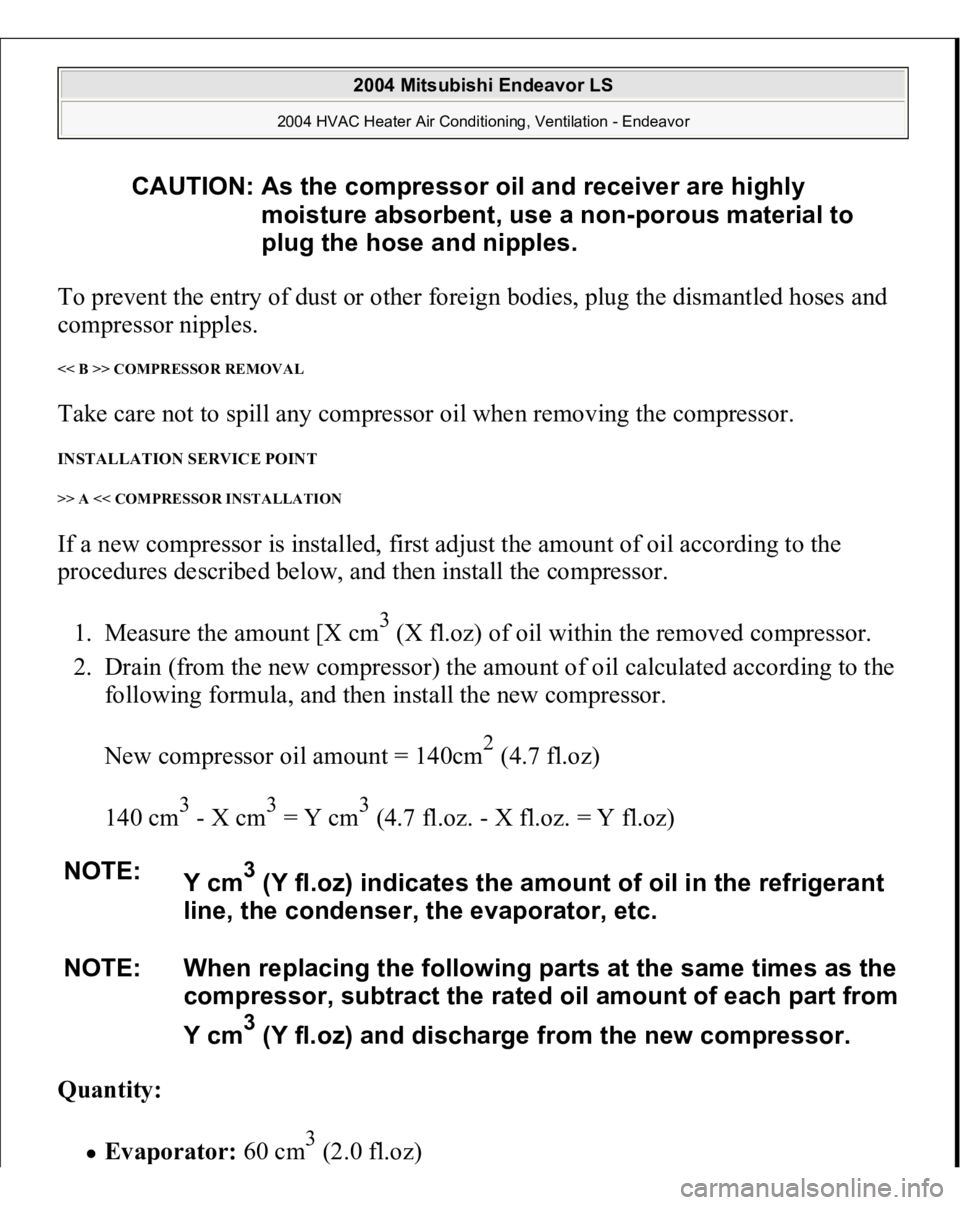
To prevent the entry of dust or other foreign bodies, plug the dismantled hoses and
compressor nipples. << B >> COMPRESSOR REMOVAL Take care not to spill any compressor oil when removing the compressor. INSTALLATION SERVICE POINT >> A << COMPRESSOR INSTALLATION If a new compressor is installed, first adjust the amount of oil according to the
procedures described below, and then install the compressor.
1. Measure the amount [X cm
3 (X fl.oz) of oil within the removed compressor.
2. Drain (from the new compressor) the amount of oil calculated according to the
following formula, and then install the new compressor.
New compressor oil amount = 140cm
2 (4.7 fl.oz)
140 cm
3 - X cm
3 = Y cm
3 (4.7 fl.oz. - X fl.oz. = Y fl.oz)
Quantity:
Eva
porator
: 60 c
m3 (2.0 fl.oz
)
CAUTION: As the compressor oil and receiver are highly
moisture absorbent, use a non-porous material to
plug the hose and nipples.
NOTE:
Y cm
3 (Y fl.oz) indicates the amount of oil in the refrigerant
line, the condenser, the evaporator, etc.
NOTE: When replacing the following parts at the same times as the
compressor, subtract the rated oil amount of each part from
Y cm3 (Y fl.oz) and discharge from the new compressor.
2004 Mitsubishi Endeavor LS
2004 HVAC Heater Air Conditioning, Ventilation - Endeavor
Page 2421 of 3870

When metering R-134a into the refrigeration system, keep the supply tank or cans
in an upright position. If the refrigerant container is on its side or upside down,
liquid refrigerant will enter the system and damage the compressor.
Refrigerant will tarnish bright metal and chrome surfaces, and in combination with
moisture can severely corrode all metal surfaces. OPERATION CONDENSER FAN AND RADIATOR FAN CONTROL
For the operation of each fan, refer to
SYMPTOM PROCEDURES
.
COMPRESSOR CONTROL WHEN OPERATING THE AIR CONDITIONING SWITCH
The air thermo sensor, which senses the temperature of the air flowing out of
the evaporator, deactivates the compressor at 3°C (37.4°F) or below. The dual pressure switch turns OFF when the refrigerant pressure becomes
excessively high or low, thus protecting the compressor circuit. When the air thermo sensor is activated, and the ignition switch, blower switch,
and air conditioning switch are ON, the A/C compressor clutch relay is
energized.
WHEN OPERATING THE MODE SELECTION DIAL
The air conditioning will work when the mode selection dial is set to the
"Defroster" or "Defroster/foot" position or the temperature control dial is set to
the "MAX A/C" position. In other dial positions, when the air conditioning
switch is turned on, the air conditioning will work.
A/C COMPRESSOR CLUTCH RELAY ON CONDITION
or it will be stained.
2004 Mitsubishi Endeavor LS
2004 HVAC Automatic Air Conditioning - Endeavor
Page 2422 of 3870
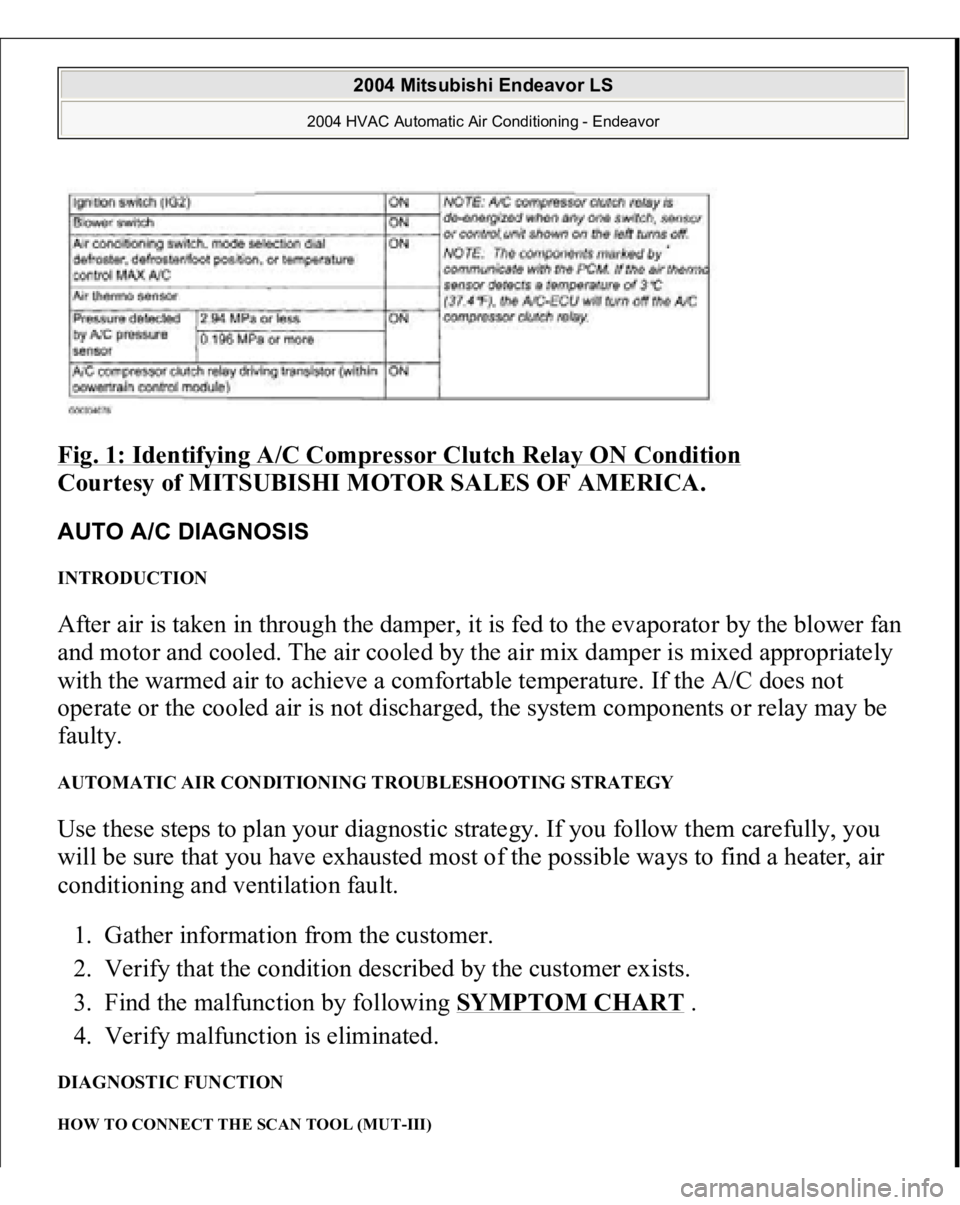
Fig. 1: Identifying A/C Compressor Clutch Relay ON Condition
Courtesy of MITSUBISHI MOTOR SALES OF AMERICA.
AUTO A/C DIAGNOSIS INTRODUCTION After air is taken in through the damper, it is fed to the evaporator by the blower fan
and motor and cooled. The air cooled by the air mix damper is mixed appropriately
with the warmed air to achieve a comfortable temperature. If the A/C does not
operate or the cooled air is not discharged, the system components or relay may be
faulty. AUTOMATIC AIR CONDITIONING TROUBLESHOOTING STRATEGY Use these steps to plan your diagnostic strategy. If you follow them carefully, you
will be sure that you have exhausted most of the possible ways to find a heater, air
conditioning and ventilation fault.
1. Gather information from the customer.
2. Verify that the condition described by the customer exists.
3. Find the malfunction by following
SYMPTOM CHART
.
4. Verify malfunction is eliminated.
DIAGNOSTIC FUNCTION HOW TO CONNECT THE SCAN TOOL (MUT-III)
2004 Mitsubishi Endeavor LS
2004 HVAC Automatic Air Conditioning - Endeavor
Page 3713 of 3870
![MITSUBISHI ENDEAVOR 2004 Service Repair Manual
2004 Mitsubishi ENDEAVOR 04 - Other Fuel > FUEL SYSTEM, OTHER [Part
090000 ]
TSB No: 0413001 NHTSA ID: , January 01, 2004 : Replacement:
Summary: electronic throttle valve (etv) initialization p MITSUBISHI ENDEAVOR 2004 Service Repair Manual
2004 Mitsubishi ENDEAVOR 04 - Other Fuel > FUEL SYSTEM, OTHER [Part
090000 ]
TSB No: 0413001 NHTSA ID: , January 01, 2004 : Replacement:
Summary: electronic throttle valve (etv) initialization p](/manual-img/19/57105/w960_57105-3712.png)
2004 Mitsubishi ENDEAVOR 04 - Other Fuel > FUEL SYSTEM, OTHER [Part
090000 ]
TSB No: 0413001 NHTSA ID: , January 01, 2004 : Replacement:
Summary: electronic throttle valve (etv) initialization procedures - service manual
revision. 2004 lancer and lancer sportback models also included. *tt
2004 Mitsubishi ENDEAVOR 04 - Power Steering > STEERING : HYDRAULIC
POWER ASSIST SYSTEM [Part 015000 ]
TSB No: 0437A001 NHTSA ID: , January 01, 2004 : Replacement:
Summary: power steering pump pressure switch replacement part availability. *tt
2004 Mitsubishi ENDEAVOR 04 - Body > STRUCTURE : BODY [Part 162000 ]
TSB No: 0342B004 NHTSA ID: , October 01, 2003 : Replacement:
Summary: water leakage may occur at the floorboard due to possible conditions. water in
the floorboard can eventually saturate the silencers under carpet, causing a musty smell.
*tt
2004 Mitsubishi ENDEAVOR 04 - Windshield Blower > VISIBILITY :
DEFROSTER/DEFOGGER SYSTEM : WINDSHIELD : BLOWER [Part 138110 ]
TSB No: 0355008 NHTSA ID: , October 01, 2003 : Replacement:
Summary: debris (such as leaves, etc) entering the front cowl area may clog the
evaporator housing drain tube. if this occurs, the evaporator housing may fill up with
condensation and overflow into the passenger compartment, and into the blower mot
2004 Mitsubishi ENDEAVOR 04 - Windshield Blower > VISIBILITY :
DEFROSTER/DEFOGGER SYSTEM : WINDSHIELD : BLOWER [Part 138110 ]
TSB No: 0355008R NHTSA ID: , October 01, 2003 : Replacement: 0355003
Summary: debris (such as leaves, etc.) entering the front cowl area may clog the
evaporator housing drain tube. if this occurs, the evaporator housing may fill up with
condensation and overflow into the passenger compartment, and into the blower mo
2004 Mitsubishi ENDEAVOR 04 - Body > STRUCTURE : BODY [Part 162000 ]
TSB No: 0342B003 NHTSA ID: , October 01, 2003 : Replacement: